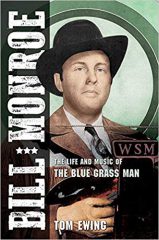When Bill Smith Monroe of Rosine, Kentucky, at the age of eight decided to play an instrument like many in his musical family did, nobody would have thought he would forever change country music.
 As singer and instrumentalist he not only revolutionized mandolin playing as he could play the instrument faster than anybody else: he was the first musician to have the mandolin play solo. Monroe (1911-1996) with his band „The Blue Grass Boys” also invented a peculiar style of country music later called “bluegrass” music. (The commercially most successful duo in bluegrass, Lester Flatt and Earl Scruggs, actually first met when they both were members of that lineup).
As singer and instrumentalist he not only revolutionized mandolin playing as he could play the instrument faster than anybody else: he was the first musician to have the mandolin play solo. Monroe (1911-1996) with his band „The Blue Grass Boys” also invented a peculiar style of country music later called “bluegrass” music. (The commercially most successful duo in bluegrass, Lester Flatt and Earl Scruggs, actually first met when they both were members of that lineup).
Called ‘The Father of Bluegrass,’ he is portrayed here in his many roles as a brother, (he had seven siblings and first played in public together with two of his older brothers), laborer, high-pitched singer, songwriter, band leader, business man, father, mentor, and most of all very exceptional musician and mandolin genius with a perfect sense for rhythm who composed more than 200 tracks and recorded dozens of albums. He took the most important stage for country music, Nashville’s Grand Ole Opry radio show, by storm with his first appearance in 1939. As author Ewing explains it, audiences “… had never experienced anything quite like this before …. They’d heard bands playing ‘fast,’ but never with the same precision and drive as this one, urged by twenty-eight-year-old Bill’s unrelenting rhythm mandolin.”
The Blue Grass Boys were subject to almost constantly changing lineups. The band history alone would fill a book. More than 150 musicians were (official) members of this elite circle over the decades, not counting the many who filled-in briefly whenever Monroe needed backup for a few shows. This is worth mentioning, as he was known to set extremely high technical standards at any audition as he was looking for exactly one performance style, and very many musicians who wanted the get into the band permanently were rejected. On the other hand, Monroe, described by many as either difficult, authoritarian or overwhelmingly friendly, depending on his daily mood, was not immune to experiments, and over the years, he changed the band’s setup and sound. He was admitted to the Country Music Hall of Fame, the Bluegrass Hall of Fame, the Rock and Roll Hall of Fame and received a Grammy Lifetime Achievement Award.
A biography/musical biography can hardly be any more precise, as this one lists all Monroe recording sessions, every band change, (almost) every little gig at any radio station, schoolhouse or festival, every title and its origin, and sometimes even the type and brand of instrument used by the artists. Author Tom Ewing, who in 2000 already published “The Bill Monroe Reader” interviewed sixty-eight band mates; this enterprise was facilitated by the fact that he was lead guitar player of the band for ten years and knew Monroe well.
At this length and with all the incredible detail in nine chapters (one for every decade of the twenty-first century) that list hundreds of songs, musicians, places, tent shows, radio broadcasts and the many little incidents that led to the creation and recording of certain (and now classic) bluegrass titles, this book is the true Bill Monroe bible.
It provides also a very vivid picture of how county and folk music was recorded, marketed, how Nashville ended up as the country music capital and the American music business changed over the decades. Highly recommended for any fan of country music or bluegrass.
Review by Dr. A. Ebert © 2019
Tom Ewing. Bill Monroe: The Life and Music of the Blue Grass Man (Music in American Life). University of Illinois Press, 2018, 656 p.
